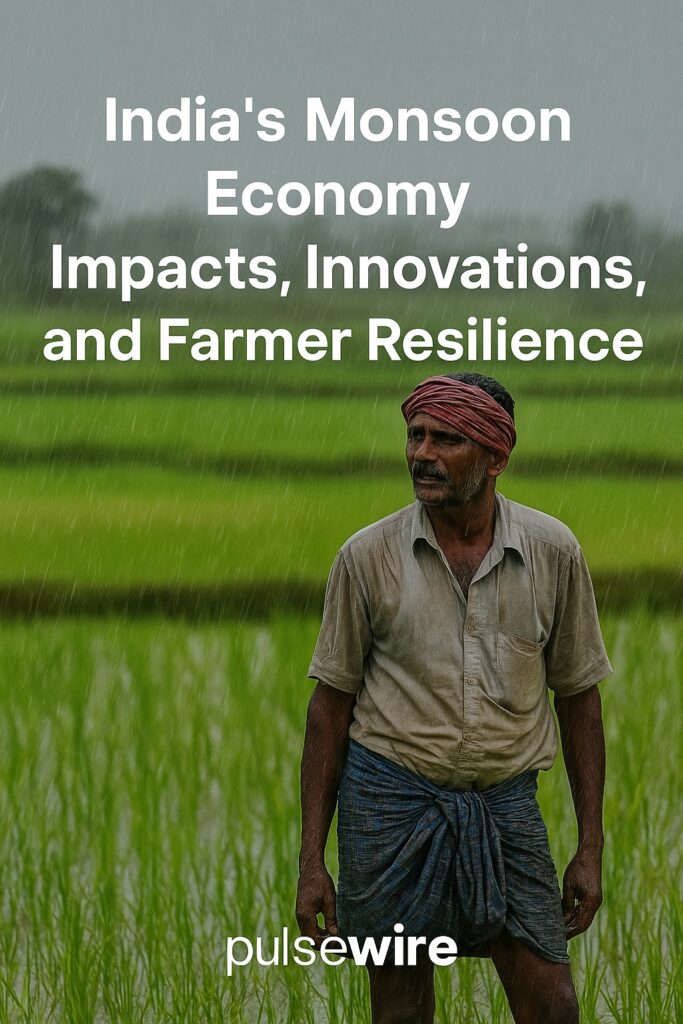
Introduction:
For India, the monsoon isn’t just a season; it’s the very heartbeat of its economy. As the clouds gather and the first drops fall, the nation holds its breath, knowing that the quality of these life-giving rains will shape the year ahead. From rural livelihoods to national GDP, monsoons have a far-reaching influence. But in the face of climate change and unpredictable weather, Indian farmers and policymakers are adapting. This article explores the deep economic ties to the monsoon, groundbreaking innovations helping agriculture thrive, and the critical support systems enabling resilience.
- The Lifeline: Monsoon’s Pivotal Role in India’s Economy
- Agricultural Backbone: Kharif crops such as rice, maize, and pulses rely heavily on monsoon rainfall. Nearly 60% of India’s net sown area is rain-fed, making monsoons vital for both crop production and groundwater replenishment.
- Rural Livelihoods: A majority of India’s rural population depends on agriculture. A good monsoon boosts employment and spending in rural areas.
- GDP Contribution: Agriculture contributes about 17-18% to India’s GDP, and monsoon health directly influences this metric.
- Food Security: Sufficient rainfall ensures a stable supply of essential crops, maintaining food affordability.
- Economic Ripples: Monsoon’s Impact on Inflation and Markets
- Food Inflation: Poor rainfall reduces crop yields, triggering price spikes in essentials. For instance, onion and tomato prices can soar during erratic monsoons, impacting household budgets.
- Overall Inflation: Food inflation can contribute to the Wholesale Price Index (WPI) and Consumer Price Index (CPI), influencing the RBI’s monetary policy.
- Stock Market & Rural Demand: A strong monsoon uplifts market sentiment. Stocks in FMCG, tractors, and fertilizers see positive movement due to expected rural demand.
- Innovations in the Fields: Farmer Resilience and Adaptation
- Climate-Resilient Crops: Institutions like ICAR are promoting drought-resistant and short-duration crop varieties to withstand erratic weather.
- Precision Farming: Technologies like weather forecasting, Soil Health Cards, and remote sensing drones help in decision-making.
- Water Management:
- Micro-irrigation: Tools like drip and sprinkler irrigation save water.
- Rainwater Harvesting: Farm ponds and check dams store rainwater locally.
- Conjunctive Use: Combining surface and groundwater effectively.
- Crop Diversification: Encouraging millets and pulses to reduce dependence on water-intensive crops.
- Government Support and Policy Interventions
- PM Fasal Bima Yojana (PMFBY): Offers insurance coverage against crop failure due to adverse weather conditions. Learn more.
- Minimum Support Prices (MSPs): Government fixes MSPs to ensure fair returns. View official MSPs.
- Irrigation Infrastructure: Schemes like Pradhan Mantri Krishi Sinchai Yojana invest in expanding irrigation reach.
- Digital Platforms:
- e-NAM: A national agri-market platform helping farmers sell their produce efficiently.
- Kisan Suvidha App: Provides weather, market prices, and advisory updates.
- Credit Support: Kisan Credit Cards (KCCs) and direct transfers ease financial burdens. More on KCC
- Challenges and the Road Ahead
- Climate Variability: Increased incidence of floods and droughts.
- Land Fragmentation: Limits mechanization and innovation access.
- Post-Harvest Issues: Storage, transport, and price realization challenges.
- Farmer Awareness: A need for greater education on modern methods and digital tools.
Conclusion:
India’s economy continues to dance to the rhythm of the monsoon. However, thanks to farmer ingenuity, cutting-edge technology, and robust government schemes, resilience is rising. With continued focus on sustainable practices, knowledge sharing, and investment, the future holds promise. As the monsoon clouds return each year, they bring not just rain, but the hope of progress and prosperity.
Author: The Pulsewire Team
Published Date: June 21, 2025








